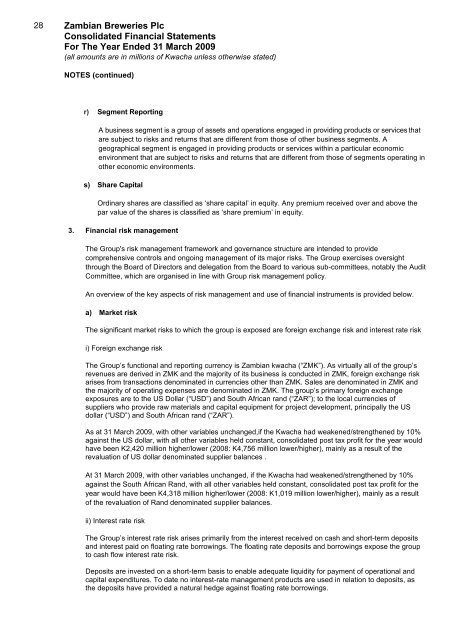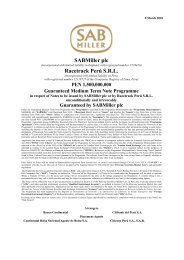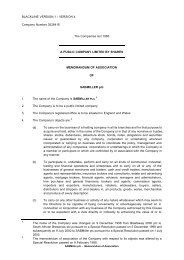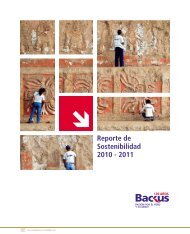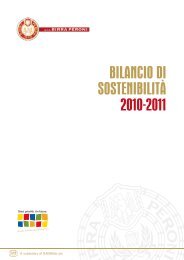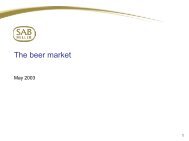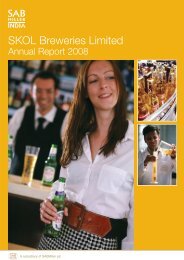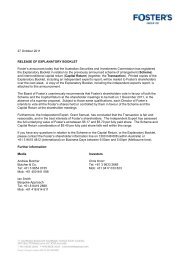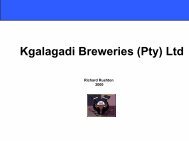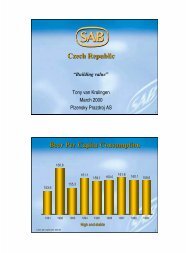Download the Zambian Breweries 2009 Annual report ... - SABMiller
Download the Zambian Breweries 2009 Annual report ... - SABMiller
Download the Zambian Breweries 2009 Annual report ... - SABMiller
You also want an ePaper? Increase the reach of your titles
YUMPU automatically turns print PDFs into web optimized ePapers that Google loves.
28 <strong>Zambian</strong> <strong>Breweries</strong> Plc<br />
Consolidated Financial Statements<br />
For The Year Ended 31 March <strong>2009</strong><br />
(all amounts are in millions of Kwacha unless o<strong>the</strong>rwise stated)<br />
NOTES (continued)<br />
r) Segment Reporting<br />
A business segment is a group of assets and operations engaged in providing products or services that<br />
are subject to risks and returns that are different from those of o<strong>the</strong>r business segments. A<br />
geographical segment is engaged in providing products or services within a particular economic<br />
environment that are subject to risks and returns that are different from those of segments operating in<br />
o<strong>the</strong>r economic environments.<br />
s) Share Capital<br />
Ordinary shares are classified as ‘share capital’ in equity. Any premium received over and above <strong>the</strong><br />
par value of <strong>the</strong> shares is classified as ‘share premium’ in equity.<br />
3. Financial risk management<br />
The Group's risk management framework and governance structure are intended to provide<br />
comprehensive controls and ongoing management of its major risks. The Group exercises oversight<br />
through <strong>the</strong> Board of Directors and delegation from <strong>the</strong> Board to various sub-committees, notably <strong>the</strong> Audit<br />
Committee, which are organised in line with Group risk management policy.<br />
An overview of <strong>the</strong> key aspects of risk management and use of financial instruments is provided below.<br />
a) Market risk<br />
The significant market risks to which <strong>the</strong> group is exposed are foreign exchange risk and interest rate risk<br />
i) Foreign exchange risk<br />
The Group’s functional and <strong>report</strong>ing currency is <strong>Zambian</strong> kwacha (“ZMK”). As virtually all of <strong>the</strong> group’s<br />
revenues are derived in ZMK and <strong>the</strong> majority of its business is conducted in ZMK, foreign exchange risk<br />
arises from transactions denominated in currencies o<strong>the</strong>r than ZMK. Sales are denominated in ZMK and<br />
<strong>the</strong> majority of operating expenses are denominated in ZMK. The group’s primary foreign exchange<br />
exposures are to <strong>the</strong> US Dollar (“USD”) and South African rand (“ZAR”); to <strong>the</strong> local currencies of<br />
suppliers who provide raw materials and capital equipment for project development, principally <strong>the</strong> US<br />
dollar (“USD”) and South African rand (“ZAR”).<br />
As at 31 March <strong>2009</strong>, with o<strong>the</strong>r variables unchanged,if <strong>the</strong> Kwacha had weakened/streng<strong>the</strong>ned by 10%<br />
against <strong>the</strong> US dollar, with all o<strong>the</strong>r variables held constant, consolidated post tax profit for <strong>the</strong> year would<br />
have been K2,420 million higher/lower (2008: K4,756 million lower/higher), mainly as a result of <strong>the</strong><br />
revaluation of US dollar denominated supplier balances .<br />
At 31 March <strong>2009</strong>, with o<strong>the</strong>r variables unchanged, if <strong>the</strong> Kwacha had weakened/streng<strong>the</strong>ned by 10%<br />
against <strong>the</strong> South African Rand, with all o<strong>the</strong>r variables held constant, consolidated post tax profit for <strong>the</strong><br />
year would have been K4,318 million higher/lower (2008: K1,019 million lower/higher), mainly as a result<br />
of <strong>the</strong> revaluation of Rand denominated supplier balances.<br />
ii) Interest rate risk<br />
The Group’s interest rate risk arises primarily from <strong>the</strong> interest received on cash and short-term deposits<br />
and interest paid on floating rate borrowings. The floating rate deposits and borrowings expose <strong>the</strong> group<br />
to cash flow interest rate risk.<br />
Deposits are invested on a short-term basis to enable adequate liquidity for payment of operational and<br />
capital expenditures. To date no interest-rate management products are used in relation to deposits, as<br />
<strong>the</strong> deposits have provided a natural hedge against floating rate borrowings.


